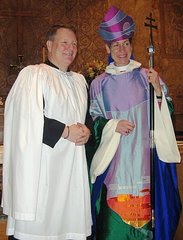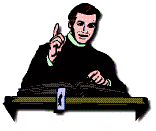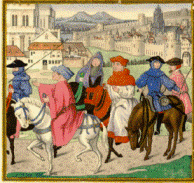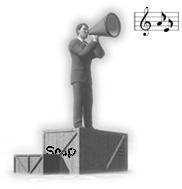It was my second Sunday in Canterbury. The day included three services, a self-tour of St. Dunstan's church, singing, a BBQ, and a beautiful sunset. Here are some scenes from the day:
 The Canterbury Scholars are serving as chalcifers for the Sunday 11:00 am Sung Eucharist during our term here. That's Victor from Sri Lanka, me, Gradwell from South Africa, some Welsh guy, and Ron from the USA.
The Canterbury Scholars are serving as chalcifers for the Sunday 11:00 am Sung Eucharist during our term here. That's Victor from Sri Lanka, me, Gradwell from South Africa, some Welsh guy, and Ron from the USA. 
Next was the discovery of the connection between Canterbury and William and Margaret Roper, daughter and son-in-law of Sir Thomas More, and More himself -- at least part of him. Margaret More Roper (famous from CH2 for being learned and lovely) and her husband lived in Canterbury on the high street leading into the city centre. This was their gate.
 In this stained glass window in St. Dunstan's Church, Canterbury More is pictured in the central panel. His devoted second wife Alice kneels at his feet. Margaret is to his right, and her husband William to his left. Margaret was thought to be the most educated woman in Europe in her day. Her humanist father saw that all his children, including his daughters, were educated to the highest standards of the then burgeoning renaissance. It is More's example that likely influenced Henry VIII in his decision to make sure that his daughter Elizabeth was educated to a similar standard.
In this stained glass window in St. Dunstan's Church, Canterbury More is pictured in the central panel. His devoted second wife Alice kneels at his feet. Margaret is to his right, and her husband William to his left. Margaret was thought to be the most educated woman in Europe in her day. Her humanist father saw that all his children, including his daughters, were educated to the highest standards of the then burgeoning renaissance. It is More's example that likely influenced Henry VIII in his decision to make sure that his daughter Elizabeth was educated to a similar standard.
 Margaret More Roper, after her father's beheading at the Tower of London on 6th July 1535, retrieved his decapitated head and had it buried in the Roper family crypt in St. Dunstan's Church, were she and her family would eventually be buried. Seems grisly, but if my understanding of the practices surrounding Tudor executions is correct, More's body would have been buried immediately after his execution in St. Peter's Ad Vincula, a small church within the gates of the Tower of London. Then his head would have been set upon a pike at the Tower or on London Bridge (or elsewhere) as a warning to others. (More was convicted of treason for refusing to sign the new oath required by parliamentary act acknowledging Henry as the head of the church in England.) Given Henry's reluctance to execute More, and his affection for his family, More's head was probably handed over to Margaret without it going on display, or shortly thereafter. Margaret saw that her father's head was duly interred in Canterbury.
Margaret More Roper, after her father's beheading at the Tower of London on 6th July 1535, retrieved his decapitated head and had it buried in the Roper family crypt in St. Dunstan's Church, were she and her family would eventually be buried. Seems grisly, but if my understanding of the practices surrounding Tudor executions is correct, More's body would have been buried immediately after his execution in St. Peter's Ad Vincula, a small church within the gates of the Tower of London. Then his head would have been set upon a pike at the Tower or on London Bridge (or elsewhere) as a warning to others. (More was convicted of treason for refusing to sign the new oath required by parliamentary act acknowledging Henry as the head of the church in England.) Given Henry's reluctance to execute More, and his affection for his family, More's head was probably handed over to Margaret without it going on display, or shortly thereafter. Margaret saw that her father's head was duly interred in Canterbury.
 Later that evening, the cathedral commemorated the feast day of William Wilburforce, a member of parliament and the evangelical wing of the Church of England. Two hundred years ago, thanks largely to the efforts of Wilburforce and his supporters, the Clapham Sect, the slave trade was outlawed in Britain and all its possessions. Wilburforce had wanted to outlaw slavery itself, and initially failed, settling for an end to the trade in slaves. Slavery itself was abolished in the British Empire in 1833-4. The Canterbury Scholars were asked to form an ad hoc choir for the service (the Cathedral Choir is on holiday). We sang, "Go Down Moses", "Steal Away", a Russian "Kyrie", and a hymn written for the anniversary called "Abolition".
Later that evening, the cathedral commemorated the feast day of William Wilburforce, a member of parliament and the evangelical wing of the Church of England. Two hundred years ago, thanks largely to the efforts of Wilburforce and his supporters, the Clapham Sect, the slave trade was outlawed in Britain and all its possessions. Wilburforce had wanted to outlaw slavery itself, and initially failed, settling for an end to the trade in slaves. Slavery itself was abolished in the British Empire in 1833-4. The Canterbury Scholars were asked to form an ad hoc choir for the service (the Cathedral Choir is on holiday). We sang, "Go Down Moses", "Steal Away", a Russian "Kyrie", and a hymn written for the anniversary called "Abolition".
 Thereafter, we were treated to a BBQ on the lawn (aka 'back garden') of Canon Ed Condry's home in the cathedral precincts. Pretty nice little place, eh? Definitely worth taking a 7:30am Matins service or two.
Thereafter, we were treated to a BBQ on the lawn (aka 'back garden') of Canon Ed Condry's home in the cathedral precincts. Pretty nice little place, eh? Definitely worth taking a 7:30am Matins service or two.
 The day ended with yet another of those beautiful English summer sunsets that seem to last and last.
The day ended with yet another of those beautiful English summer sunsets that seem to last and last.
 The Canterbury Scholars are serving as chalcifers for the Sunday 11:00 am Sung Eucharist during our term here. That's Victor from Sri Lanka, me, Gradwell from South Africa, some Welsh guy, and Ron from the USA.
The Canterbury Scholars are serving as chalcifers for the Sunday 11:00 am Sung Eucharist during our term here. That's Victor from Sri Lanka, me, Gradwell from South Africa, some Welsh guy, and Ron from the USA. 


 Thereafter, we were treated to a BBQ on the lawn (aka 'back garden') of Canon Ed Condry's home in the cathedral precincts. Pretty nice little place, eh? Definitely worth taking a 7:30am Matins service or two.
Thereafter, we were treated to a BBQ on the lawn (aka 'back garden') of Canon Ed Condry's home in the cathedral precincts. Pretty nice little place, eh? Definitely worth taking a 7:30am Matins service or two.








2 comments:
Mark, your description of Margaret Roper, learned (and lovely!)daughter of Thomas More, moves me to tears. I'm sobbing copiously all over my keyboard. ::sniff::
Hey Mark,
Nice blog! Hope you enjoy the rest of your times there. I'll be here slogging through CPE with the rest of the jun, er, I mean middlers. Oh to be a rising senior!
Stephanie Shockley
Post a Comment